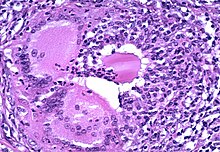Thyroiditis
| Thyroiditis | |
|---|---|
 | |
| Above shows two parts of the thyroid that could potentially be affected if diagnosed with thyroiditis. | |
| Specialty | Endocrinology |
Thyroiditisis the inflammation of thethyroid gland.The thyroid gland is located on the front of the neck below thelaryngeal prominence,and makes hormones that control metabolism.
Signs and symptoms
[edit]There are many different signs and symptoms for thyroiditis, none of which are exclusively limited to this disease. Many of the signs imitate symptoms of other diseases, so thyroiditis can sometimes be difficult to diagnose. Commonhypothyroidsymptoms manifest when thyroid cell damage is slow and chronic, and may include fatigue, weight gain, feeling "fuzzy headed", depression, dry skin, and constipation. Other, rarer symptoms include swelling of the legs, vague aches and pains, decreased concentration and so on. When conditions become more severe, depending on the type of thyroiditis, one may start to see puffiness around the eyes, slowing of the heart rate, a drop in body temperature, or even incipient heart failure. On the other hand, if the thyroid cell damage is acute, the thyroid hormone within the gland leaks out into the bloodstream causing symptoms of thyrotoxicosis, which is similar to those ofhyperthyroidism.These symptoms include weight loss, irritability, anxiety, insomnia, fast heart rate, and fatigue. Elevated levels of thyroid hormone in the bloodstream cause both conditions, but thyrotoxicosis is the term used with thyroiditis since the thyroid gland is not overactive, as in the case of hyperthyroidism.[1]
Causes
[edit]Thyroiditis is generally caused by an immune system attack on the thyroid, resulting in inflammation and damage to the thyroid cells. This disease is often considered a malfunction of the immune system and can be associated with IgG4-related systemic disease, in which symptoms of autoimmune pancreatitis, retroperitoneal fibrosis and noninfectious aortitis also occur. Such is also the case in Riedel thyroiditis, an inflammation in which the thyroid tissue is replaced by fibrous tissue which can extend to neighbouring structures. Antibodies that attack the thyroid are what causes most types of thyroiditis. It can also be caused by an infection, like avirusorbacteria,which works in the same way as antibodies to cause inflammation in the glands, such as in the case of subacute granulomatous thyroiditis (de Quervain).[2]Certain people makethyroid antibodies,and thyroiditis can be considered anautoimmune disease,because the body acts as if the thyroid gland is foreign tissue.[3]Some drugs, such asinterferon,lithium,amiodarone(AIT type-2) andimmune check point inhibitorscan also cause thyroiditis.[4]
Diagnosis
[edit]Diagnosis of thyroiditis depends on the specific cause and clinical context. When the initial presentation isthyrotoxicosis,work-up will include causes of thyroiditis as well as causes of hyperthyroidism. In some types of thyroiditis, aphysical exammay reveal anenlarged thyroidand/or tenderness topalpation.Ifinfectious thyroiditisis suspected a neckultrasoundcan be utilized to check for anabscess.Color flow doppleris expected to show reduced blood flow in thyroiditis vs. hyperthyroidism.[5]Blood tests will usually includethyroid function testsas well levels of specific thyroidantibodiesandthyroglobulin.Inflammatory markers such aswhite blood cell count,erythrocyte sedimentation rateandc-reactive proteinmay be elevated in some forms of thyroiditis. Thegold-standardfor diagnosis of thyroiditis is the lack of tracer uptake in aradionuclide uptake scansuch asradioactive iodine,technetium-99morsetamibi.[6]Importantly, recent exposure to an intravenous iodine basedradio-contrastagent may lead to falsely low uptake due to saturation with iodine.[7]
Classification
[edit]
Thyroiditis is a group of disorders that all cause thyroidal inflammation. Forms of the disease areHashimoto's thyroiditis,the most common cause of hypothyroidism in the US,postpartum thyroiditis,subacute thyroiditis,silent thyroiditis,drug-induced thyroiditis,radiation-induced thyroiditis,acute thyroiditis,Riedel's thyroiditis.[8]
Treatment
[edit]Treatments for this disease depend on the type of thyroiditis that is diagnosed. For the most common type, which is known as Hashimoto's thyroiditis, the treatment is to immediately start hormone replacement. This prevents or corrects the hypothyroidism, and it also generally keeps the gland from getting bigger. However, Hashimoto's thyroiditis can initially present with excessive thyroid hormone being released from the thyroid gland (hyperthyroid). In this case the patient may only need bed rest andnon-steroidal anti-inflammatory medications;however, some need steroids to reduce inflammation and to control palpitations. Also, doctors may prescribebeta blockersto lower the heart rate and reduce tremors, until the initial hyperthyroid period has resolved.[9]
Epidemiology
[edit]Most types of thyroiditis are three to five times more likely to be found in women than in men. The average age of onset is between thirty and fifty years of age. This disease tends to be geographical and seasonal, and is most common in summer and fall.[1]
History
[edit]Hashimoto's thyroiditiswas first described by Japanese physician Hashimoto Hakaru working in Germany in 1912. Hashimoto's thyroiditis is also known as chronic lymphocytic thyroiditis, and patients with this disease often complain about difficulty swallowing. This condition may be so mild at first that the disease goes unnoticed for years. The first symptom that shows signs of Hashimoto's thyroiditis is a goiter on the front of the neck. Depending on the severity of the disease and how much it has progressed, doctors then decide what steps are taken for treatment.[citation needed]
See also
[edit]References
[edit]- ^abPatel DS (June 2023)."Thyroiditis".Familydoctor.org.American Academy of Family Physicians.Retrieved8 October2018.
- ^De Groot LJ, Nobuyuki A, Takashi A."Hashimoto's Thryoiditis".TDM.Thyroid Disease Manager.Retrieved3 March2008.
- ^Ferry R (8 September 2007)."Hashimoto's Thyroiditis Symptoms, Diet, and Treatments".MedicineNet.Retrieved9 March2008.
- ^Pollack R, Stokar J, Lishinsky N, Gurt I, Kaisar-Iluz N, Shaul ME, et al. (June 2023)."RNA Sequencing Reveals Unique Transcriptomic Signatures of the Thyroid in a Murine Lung Cancer Model Treated with PD-1 and PD-L1 Antibodies".International Journal of Molecular Sciences.24(13): 10526.doi:10.3390/ijms241310526.PMC10341615.PMID37445704.
- ^Zhao X, Chen L, Li L, Wang Y, Wang Y, Zhou L, et al. (2012)."Peak systolic velocity of superior thyroid artery for the differential diagnosis of thyrotoxicosis".PLOS ONE.7(11): e50051.Bibcode:2012PLoSO...750051Z.doi:10.1371/journal.pone.0050051.PMC3500337.PMID23166817.
- ^Itzkovich D, Ben-Haim S, Godefroy J, Stokar J (January 2023)."99mTc MIBI Scintigraphy for Classification of Amiodarone-induced Thyrotoxicosis ".JCEM Case Reports.1(1): luac011.doi:10.1210/jcemcr/luac011.PMC10578384.PMID37908259.
- ^Vassaux G, Zwarthoed C, Signetti L, Guglielmi J, Compin C, Guigonis JM, et al. (January 2018). "Iodinated Contrast Agents Perturb Iodide Uptake by the Thyroid Independently of Free Iodide".Journal of Nuclear Medicine.59(1): 121–126.doi:10.2967/jnumed.117.195685.PMID29051343.
- ^"Thyroiditis"(en).www.thyroid.org.American Thyroid Association. 2018.Retrieved8 October2018.
- ^Ross D (November 2023). Cooper D (ed.)."Beta blockers in the treatment of hyperthyroidism".UpToDate.Waltham, MA: Wolters Kluwer.Retrieved27 July2017.
